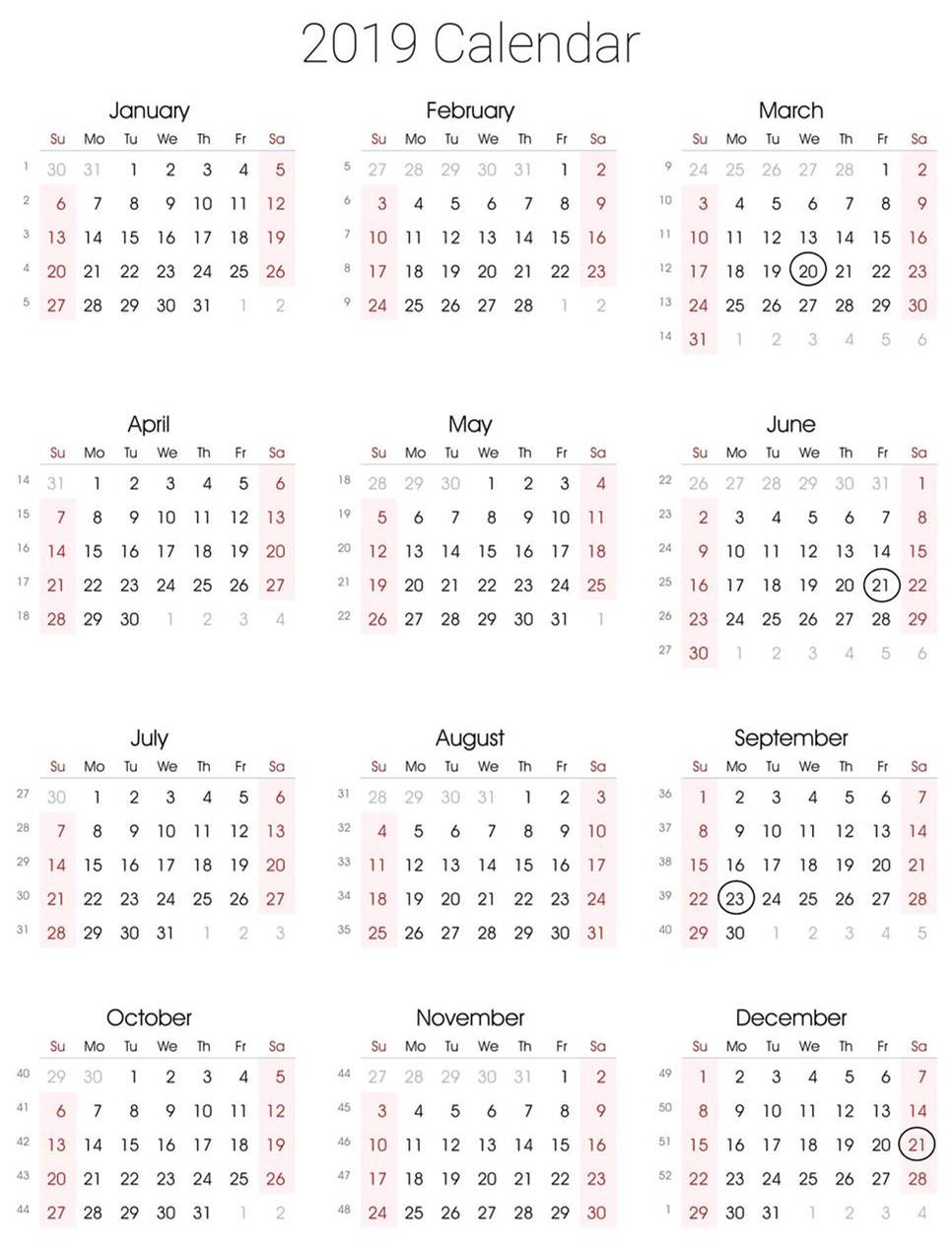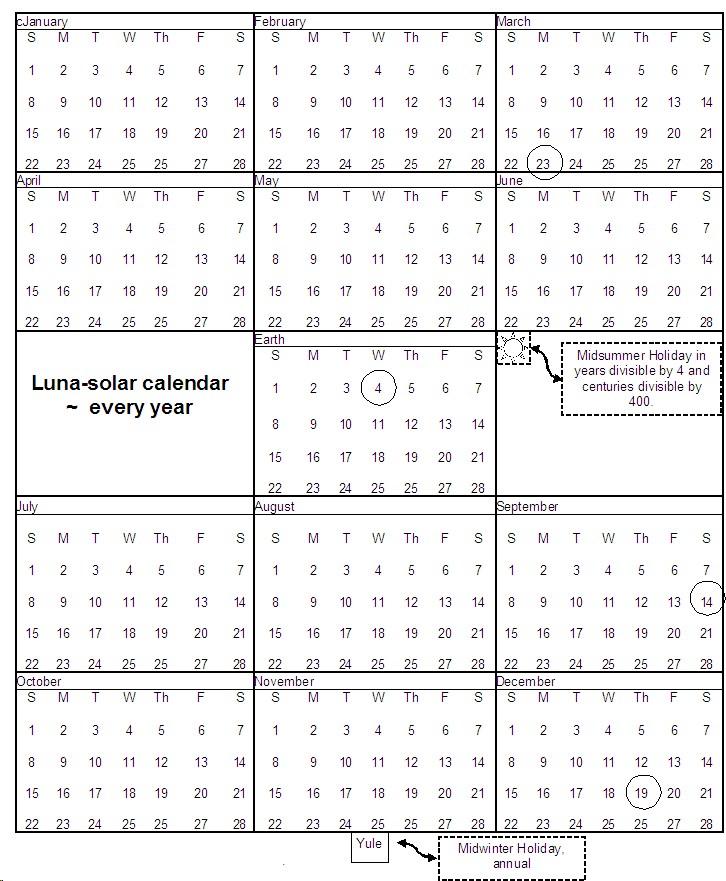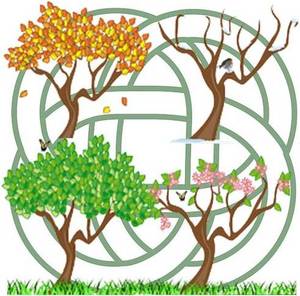Image: OpenClipart-Vectors, Clker-Free-Vector, Pixabay CCO, adapted
As I write this, the entire world prepares to welcome the year 2019 CE. And, thus will begin another cycle of 31-28-31-30-31 – use your knuckles or a mnemonic device – and the resulting inescapable question, “What’s the date today?”
I’d often wondered how the simple passage of time – sunrise, sunset – got so complicated.
The nonsensical names of our months September through December derive from the Latin septem, octo, novem and decem - 7, 8, 9 and 10 – but these are the 9th, 10th, 11th, and 12th months of the year. Julius and Augustus Caesar each named July, then August after themelves. Did they simply insert these months?
When I extricated myself from Western culture to live an earth-centered life, I changed my view of seasonal beginnings to align with planting and harvesting. And, a lunar calendar, similar to those used by many indigenous cultures, made more sense. The Gregorian calendar divides the year into 12 months roughly equivalent to the 12 constellations (but not quite) and of roughly equal length (well, sort of - 31, 28, 31, 30, 31, 30, 31, 31, 30, 31, 30, 31) named for Greek, Roman and Norse gods and Roman emperors.
A lunar calendar of thirteen 28-day months would mean the date of each day of the week is exactly the same every month – and every year! One calendar. Period. The year is 364 days with 1 free, unnumbered holiday added between December and January and another during leap years right after June at midsummer. Simple!
A comparison shows the differences. Circles indicate equinoxes and solstices - points of Earth's orbit. Holidays remain the same.
Gregorian Calendar

Lunar Calendar

So what happened? I ventured down the calendar rabbit hole to discover that Julius renamed the 5th month (Quintilis) and Augustus, the 6th (Sextilis). The original Roman calendar had ten months; two more had to be inserted. There have been over 80 types of calendars since the Bronze Age. Some fourth of these are based on the Gregorian, a reform instituted February 24, 1582 by Pope Gregory XIII and created by Aloysius Lilius and Christopher Clavius to correct the Julian calendar, itself a correction made by Julius Caesar with astrologer Sosigenes of Alexandria of the prior ten-month calendar.
The complexity arises mathematically. A minute error in calculating Earth’s orbit can result, over centuries, in a calendar days longer than the orbital year and out of synch with Earth’s seasons (caused by the axial tilt, not the orbit). “Earth completes one orbit every 365.242199 mean solar days.” Not 365.25. Astronomers use an Intercalation or embolism (leap year) every four years which, over the 1500 years between Caesar and Gregory, had resulted 10 extra days. Lilius changed the 4th-year leap year to exclude centenary years not divisible by 400, correcting the number of leap years by 0.75% (from 100 years out of 400 down to 97) to more closely approximate the .007801 difference between 365.242199 and 365.25.
Indigenous cultures tend to be Earth-based and egalitarian. The sun, more often identified with the male, travels through 12 western-identified constellations while each of the moon’s 13 cycles, is more associated with the female. “The Moon takes 27.3 days to orbit Earth, but the lunar phase cycle (from new Moon to new Moon) is 29.5 days. The Moon spends the extra 2.2 days "catching up" because Earth travels about 45 million miles around the Sun during the time the Moon completes one orbit around Earth.” Thus, one complete earth orbit around the sun takes 12.3811 moon cycles, not 13. More difficult to correct the .6189 difference? Sun preference?
Coordinating the northern hemisphere seasons of the prevailing cultures with their calendar was a priority in their calculations. Yet, the seasons have long seemed to me at odds with their prescribed dates, e.g. December 21st felt late for winter’s debut. When I learned how the indigenous of Europe – the Celts – viewed the year, I was living more in synch with what’s outdoors than what’s indoors and their view made sense. That’s why I’ve loved and shared the following article since first reading it several years ago. Here is affirmation, from another woman who works with and loves the land where she lives and her fellow creatures.
Rethinking the Seasons
Katie Kulla, 2011, Oak Hill Organics
Recently, I learned a simple bit of information that profoundly changed the way I look at the world around me, especially the cycles of life and work here on our Oregon vegetable farm. Apparently the Celts and other ancient peoples did not mark the seasons the way that we modern peoples do, with the winter solstice marking the start of winter, the spring equinox the start of spring, etc. Instead, these days indicated the peak of each season, so that the winter solstice (i.e., “midwinter night”) fell in the middle of winter with winter beginning at Halloween and ending at the beginning of February (Groundhog Day!).
Likewise, spring would begin at the beginning of February, summer at the beginning of May, and autumn at the beginning of August. Again, in the middle of each of these periods would come a solstice or equinox event, marking the zenith of the season. Some contemporary people, including neopagans, still recognize these shifted seasons. For what it’s worth, I think I might be joining their ranks. It just fits my experience of the natural world so much more accurately.
When August arrives each year, I start to feel a hint of fall in the air, even as the heat continues. The onions dry down, and we begin harvesting the storage crops. So, even though September 21 is still several weeks out, the work, weather and world feel like the beginnings of autumn to me every August. Similarly, as I write this essay in late November, the weather feels very much like winter. Almost all of the leaves are gone from the trees, and snow is in the forecast for tonight, followed by a very hard freeze. Everything about the season says, “winter! winter! winter!”
Also, these shifted seasons better correspond to the relative power of the sun. The six weeks before and six weeks after the winter solstice mark the quarter of the year when the sun’s influence is weakest. Likewise, the six weeks before and six weeks after the summer solstice mark the quarter of the year when the sun is strongest and plants have the most growth and photosynthetic potential. Obviously, just because I mentally think of right now as winter, the rest of the world will continue to call it autumn. And, the notion of dividing the year into four quarters and calling them by names is a human construct. Not that the shifts in weather, life cycles, and landscape aren’t real— still, we could probably divide the year just as easily into eighths or sixths if we were so inclined.
Or maybe four seasons do naturally make most sense in a temperate northern hemisphere geography (contemporary Oregon or ancient British Isles), but other people in other places have identified seasons that make more sense for their locale (for example, simply wet season and dry season). Either way, it’s useful to have language and categories for thinking about our annual cycles. The passing of the seasons is such an integral part of our life that without making a conscious effort we have developed a routine of seasonal observations that mark our year on the farm.
Some of the observation is just related to how our work changes over the year — sowing seeds in February (now the start of spring in my mind), planting in May (now the start of summer in my mind), harvesting in August (now the start of autumn in my mind), winterizing the farm in November (now the start of winter in my mind). But, equally significant to our experience of the seasons is the food we eat. It’s amazing to think back to our pre-farming life and remember that my husband and I ate the same foods year-round, regardless of the weather or season (a lot of broccoli and tofu!). Now, as farmers, our diet changes dramatically from month to month as new foods come into season and others drop out. True to form, November has brought very wintery foods to our table: pot roasts with vegetables, roasted squash, soups of all kinds. Our diet has become infinitely more interesting and pleasurable over the recent years. I enjoy eating this way so much that I can’t help but think this is part of the joy of living in the world. People spend their lives searching for fulfillment and entertainment while often missing the simple natural interest provided by the cycles of the world. Eating broccoli every day is boring — but eating roasted fall broccoli and knowing that it won’t be around again until June, that is truly exciting! How much more pleasure is there in eating foods whose moment in our diet is fleeting?
If you are a fellow seasonal vegetable eater, you too are experiencing the year’s rhythms in your diet — tasting the summer heat distilled into a ripe tomato in July and the sweetness of frost in November Brussels sprouts. Perhaps you too have found pleasure in the direct connection to the natural world provided by your fresh vegetables. We’re about to go into the hardest part of the vegetable year. We’re moving into the heart of winter (as I now understand it) — the darkest, coldest weeks of the year.
The next couple hours will be the first test of how well we have winterized our farm this year. Work on the farm has been busy the last few days: row covering crops, turning off hydrants, and harvesting, harvesting, harvesting.
Last winter we experienced a devastatingly long cold snap, and we knew we needed to do something different this year. So we built more conditioned vegetable storage space. And now it’s full of cabbages, potatoes, carrots, and more. Fortunately, winter vegetables hold well in cold storage. In some cases, these crops should do better in our cooler than in the fields. Anyhow, this week is Thanksgiving, and on my list of thanks will be a new appreciation for the pattern of the seasons and the cycle of the year. No matter how you look at these things, winter is here or soon to arrive. As its quiet coldness forces you indoors for contemplation, may you too have many interesting new things to be thankful for, as well as many wonderfully mundane things too (such as family, health, home).
Visit Katie's website for more of her writing on earth-centered farming.






